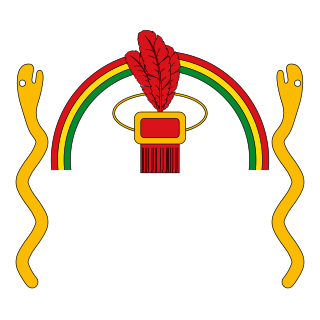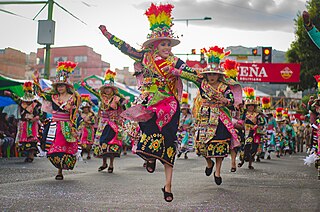
The Inca Empire, called Tawantinsuyu by its subjects, was the largest empire in pre-Columbian America. The administrative, political, and military center of the empire was in the city of Cusco. The Inca civilization rose from the Peruvian highlands sometime in the early 13th century. The Spanish began the conquest of the Inca Empire in 1532 and by 1572, the last Inca state was fully conquered.

Quechua, usually called Runasimi in Quechuan languages, is an indigenous language family spoken by the Quechua peoples, primarily living in the Peruvian Andes. Derived from a common ancestral language, it is the most widely spoken pre-Columbian language family of the Americas, with an estimated 8–10 million speakers as of 2004. Approximately 25% of Peruvians speak a Quechuan language.

Quipu are recording devices fashioned from strings historically used by a number of cultures in the region of Andean South America.

Aymara is an Aymaran language spoken by the Aymara people of the Bolivian Andes. It is one of only a handful of Native American languages with over one million speakers. Aymara, along with Spanish and Quechua, is an official language in Bolivia and Peru. It is also spoken, to a much lesser extent, by some communities in northern Chile, where it is a recognized minority language.

Luzmila Carpio is a Bolivian singer, who has performed in Spanish and Quechua, and former Bolivian ambassador to France from 2006 to 2010.

Tinku, a Bolivian Aymara tradition, began as a form of ritualistic combat. In the Quechua language, it means “meeting-encounter". During this ritual, men and women from different communities will meet and begin the festivities by dancing. The women will then form circles and begin chanting while the men proceed to fight each other; eventually the women will join in the fighting as well. Large tinkus are held in Potosí during the first few weeks of May.

Quechua people or Quichua people may refer to any of the indigenous peoples of South America who speak the Quechua languages, which originated among the Indigenous people of Peru. Although most Quechua speakers are native to Peru, there are some significant populations in Ecuador, Bolivia, Chile, Colombia, and Argentina.

South Bolivian Quechua, also known as Central Bolivian Quechua, is a dialect of Southern Quechua spoken in Bolivia and adjacent areas of Argentina, where it is also known as Colla. It is not to be confused with North Bolivian Quechua, which is spoken on the northern Andean slopes of Bolivia and is phonologically distinct from the South Bolivian variety. Estimates of the number of speakers of South Bolivian Quechua range from 2.3 to 2.8 million, making it the most spoken indigenous language in Bolivia, just slightly greater than Aymara, with roughly 2 million speakers in Bolivia. In comparison, the North Bolivian dialect has roughly 116,000 speakers.

The Andean cock-of-the-rock, also known as tunki (Quechua), is a large passerine bird of the cotinga family native to Andean cloud forests in South America. It is the national bird of Peru. It has four subspecies and its closest relative is the Guianan cock-of-the-rock.

The Indigenous peoples of Peru, or Native Peruvians, comprise a large number of ethnic groups who inhabit territory in present-day Peru. Indigenous cultures developed here for thousands of years before the arrival of the Spanish in 1532.
Q'ero is a Quechua-speaking community or ethnic group dwelling in the province of Paucartambo, in the Cusco Region of Peru.

The Kallawaya are an indigenous group living in the Andes of Bolivia. They live in the Bautista Saavedra Province and Muñecas Province of the La Paz Department but are best known for being an itinerant group of traditional healers that travel on foot to reach their patients. According to the UNESCO Safeguarding Project, the Kallawaya can be traced to the pre-Inca period as direct descendants of the Tiwanaku and Mollo cultures, meaning their existence has lasted approximately 1,000 years. They are known to have performed complex procedures like brain surgery alongside their continuous use of medicinal plants as early as 700 AD. Most famously, they are known to have helped to save thousands of lives during the construction of the Panama Canal, in which they used traditional plant remedies to treat the malaria epidemic. Some historical sources even cite the Kallawayas as the first to use quinine to prevent and control malaria. In 2012, there were 11,662 Kallawaya throughout Bolivia.

Quyllurit'i or Qoyllur Rit'i is a syncretic religious festival held annually at the Sinakara Valley in the southern highlands Cusco Region of Peru. Local indigenous people of the Andes know this festival as a native celebration of the stars. In particular they celebrate the reappearance of the Pleiades constellation, known in Quechua as Qullqa, or "storehouse," and associated with the upcoming harvest and New Year. The Pleiades disappears from view in April and reappears in June. The new year is marked by indigenous people of the Southern Hemisphere on the Winter Solstice in June, and it is also a Catholic festival. The people have celebrated this period of time for hundreds if not thousands of years. The pilgrimage and associated festival was inscribed in 2011 on the UNESCO Intangible Cultural Heritage Lists.

Pachamama is a goddess revered by the indigenous peoples of the Andes. In Inca mythology she is an "Earth Mother" type goddess, and a fertility goddess who presides over planting and harvesting, embodies the mountains, and causes earthquakes. She is also an ever-present and independent deity who has her own creative power to sustain life on this earth. Her shrines are hallowed rocks, or the boles of legendary trees, and her artists envision her as an adult female bearing harvests of potatoes or coca leaves. The four cosmological Quechua principles – Water, Earth, Sun, and Moon – claim Pachamama as their prime origin. Priests sacrifice offerings of llamas, cuy, children and elaborate, miniature, burned garments to her. Pachamama is the mother of Inti the sun god, and Mama Killa the moon goddess. Mama Killa is said to be the wife of Inti.

The Andean civilizations were South American complex societies of many indigenous people. They stretched down the spine of the Andes for 4,000 km (2,500 mi) from southern Colombia, to Ecuador and Peru, including the deserts of coastal Peru, to north Chile and northwest Argentina. Archaeologists believe that Andean civilizations first developed on the narrow coastal plain of the Pacific Ocean. The Caral or Norte Chico civilization of coastal Peru is the oldest known civilization in the Americas, dating back to 3500 BCE. Andean civilization is one of the six "pristine" civilizations of the world, created independently and without influence by other civilizations.
North Junín Quechua is a language dialect of Quechua spoken throughout the Andean highlands of the Northern Junín and Tarma Provinces of Perú. Dialects under North Junín Quechua include Tarma Quechua spoken in Tarma Province and the subdialect San Pedros de Cajas Quechua. North Junín Quechua belongs to the Yaru Quechua dialect cluster under the Quechua I dialects. Initially spoken by Huancas and neighboring native people, Quechua's Junín dialect was absorbed by the Inca Empire in 1460 but relatively unaffected by the Southern Cuzco dialect. The Inca Empire had to defeat stiff resistance by the Huanca people.

The pacha was an Incan concept for dividing the different spheres of the cosmos in Incan mythology. There were three different levels of pacha: the hana pacha, hanan pacha or hanaq pacha, ukhu pacha, and kay pacha .The realms are not solely spatial, but were simultaneously spatial and temporal. Although the universe was considered a unified system within Incan cosmology, the division between the worlds was part of the dualism prominent in Incan beliefs, known as Yanantin. This dualism found that everything which existed had both features of any feature.

Indigenous peoples in Bolivia, or Native Bolivians, are Bolivian people who are of indigenous ancestry. They constitute anywhere from 40 to 70% of Bolivia's population of 11,306,341, depending on different estimates, and belong to 36 recognized ethnic groups. Aymara and Quechua are the largest groups. The geography of Bolivia includes the Andes, the Gran Chaco, and the Amazon Rainforest.

Indigenous American philosophy is the philosophy of the Indigenous peoples of the Americas. An Indigenous philosopher is an Indigenous American person who practices philosophy and has a vast knowledge of history, culture, language, and traditions of the Indigenous peoples of the Americas. Many different traditions of philosophy exist in the Americas, and have from Precolumbian times.

The indigenous languages of South America are those whose origin dates back to the pre-Columbian era. The subcontinent has great linguistic diversity, but, as the number of speakers of indigenous languages is diminishing, it is estimated that it could become one of the least linguistically diverse regions of the planet.


















